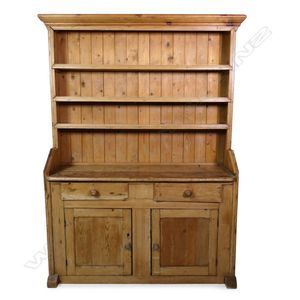Rustic Pine Kitchen Dresser with Missing Pediment
A Victorian country pine kitchen dresser, the back with three shelves, the base with two half drawers, two panelled doors, in rustic condition, (one side missing from pediment). 131 x 46 x 184 cm.
You must be a subscriber, and be logged in to view price and dealer details.
Subscribe Now to view actual auction price for this item
When you subscribe, you have the option of setting the currency in which to display prices to $Au, $US, $NZ or Stg.
This item has been sold, and the description, image and price are for reference purposes only.
- Rustic - Rustic is defined as "of, relating to, or typical of country life or country people", and the items illustrated in this price guide accord with that definition.
But in the 18th and 19th century "rustic furniture" had a narrower definition. It referred to furniture where the framework was carved or moulded to resemble tree trunks and branches, and was usually for outdoor use. Rustic furniture was made in cast iron, wood, terracootta and concrete. Much of the Coalbrookdale company's cast iron furniture was of rustic design. - Victorian Period - The Victorian period of furniture and decorative arts design covers the reign of Queen Victoria from 1837 to 1901. There was not one dominant style of furniture in the Victorian period. Designers used and modified many historical styles such as Gothic, Tudor, Elizabethan, English Rococo, Neoclassical and others, although use of some styles, such as English Rococo and Gothic tended to dominate the furniture manufacture of the period.
The Victorian period was preceded by the Regency and William IV periods, and followed by the Edwardian period, named for Edward VII (1841 ? 1910) who was King of the United Kingdom and the British Dominions and Emperor of India for the brief period from 1901 until his death in 1910. - Pediment - The uppermost section of a tall usually double-heightened piece of cabinet furniture, surmounting the cornice. The pediment can take a variety of forms derived from the architecture of classical antiquity. A broken pediment is of triangular shape, however, the two raised sides do not meet at the apex but are 'broken' the gap between them often ornamented with an urn or finial. Swan-neck pediments are of similar form, although the uprights are gracefully arched, resembling a swan's neck. They are often found, for example, on longcase clocks.
This item has been included into following indexes:
- dressers, age or origin - Victorian 14
- dressers, style or type
- dressers, timber - pine 88
